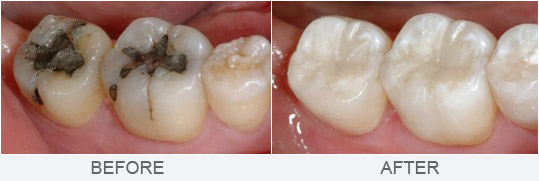
Fillings
Composite resins, or tooth-colored fillings, provide good durability and resistance to fracture in small- to mid-sized fillings that need to withstand moderate pressure from the constant stress of chewing. They can be used on either front or back teeth. They are a good choice for people who prefer that their fillings look more natural.
Composites cost more than amalgam and occasionally are not covered by some insurance plans. Also, no dental filling lasts forever. Some studies show that composite fillings can be less durable and need to be replaced more often than amalgam fillings.
It generally takes longer to place a composite filling than it does for a metal filling. That’s because composite fillings require the tooth be kept clean and dry while the cavity is being filled. Tooth-colored fillings are now used more often than amalgam or gold fillings, probably due to cosmetics. In a society focused on a white, bright smile, people tend to want fillings that blend with the natural color of their teeth.

Amalgam Filling
Because of their durability, these silver-colored fillings are often the best choice for large cavities or those that occur in the back teeth where a lot of force is needed to chew. Amalgam hardens quickly so it is useful in areas that are difficult to keep dry during placement, such as below the gum line. Because it takes less time to place than tooth-colored fillings, amalgam is also an effective material for children and special needs people who may have a difficult time staying still during treatment.
Dr. Cox and Dr. Patel will help you determine the best filling for your individual needs and situation.

